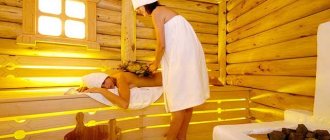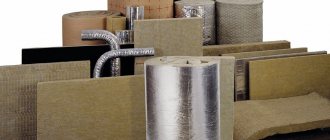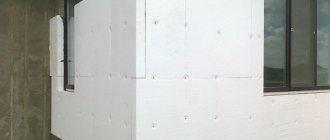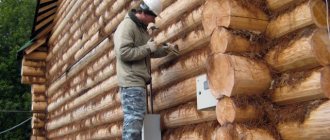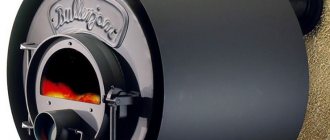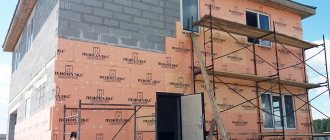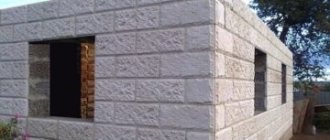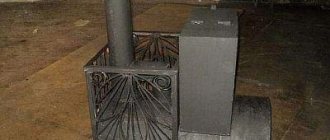Anyone who has decided to engage in frame construction understands that a lot depends on insulation.
And here a number of questions arise: what insulation to choose, how to insulate it, is it worth insulating the floor or ceiling additionally, or paying special attention to the walls?
If we are talking about the construction of a frame bath, then it is extremely important not to make a mistake, since this room is subject to the influence of high humidity and large temperature changes.
Therefore, when insulating a frame bath, you must approach the process with full responsibility.
A mistake can result in you getting constantly damp walls that are completely unable to retain heat. Insulation can be done with your own hands.
DIY bath frame
Content
- The procedure for insulating a frame bath
- Insulating the walls of a frame bath
- Insulating the floor in a frame bath
- Insulation of the ceiling of a frame bath
- Insulation of the steam room (steam room) of a frame bath
- Materials for insulating a frame bath
- PPU
- Styrofoam
A frame bath is a prefabricated structure. It is built from wooden beams. Such a structure is easy to move from place to place, install on wooden piles, adjust the distance to the ground, and arrange water drainage. To repair a bathhouse or replace building elements, it is not necessary to disassemble the entire structure. Insulation of a frame bath is part of the construction process. The walls of the bathhouse are a cake with a vapor barrier, waterproofing and a layer of insulation. The baths are insulated during construction.
What to consider when buying insulation?
Having weighed all the pros and cons, it becomes clear that insulating a bathhouse with foam plastic is the best option. The amount of insulation you need to purchase will depend on several factors. Firstly, the climate zone: in a warmer climate, much less material will be required than in regions where the thermometer can drop to -20 degrees or below. The material of the walls is also an important factor: stone structures retain heat worse than wooden ones, which means they will require more insulation.
In addition to the material of the walls, the baths differ in type: in addition to the Russian “black” and “white” baths, there are the Finnish sauna, the German “Sanarium”, the Turkish “Hamam” and the Japanese “Ofuro”. Each of them has its own specifics, which must be taken into account when insulating a structure.
Regardless of the type of bathhouse, its geographical location and wall material, foam insulation must be purchased with a slight excess (10-15% of the calculated quantity), the same rule should be followed when purchasing materials for securing the insulation. This approach will allow you to avoid shortages of material in the event of defects or damage that occur during the execution of work.
After you insulate your steam room with polystyrene foam, you will be able to feel from your own experience how much the quality of the bathing procedure has improved, since it will be possible to heat the steam room to 100 degrees and higher much faster than before (the exact time depends on the area of the room). At the same time, much less fuel will be spent on kindling. Owners of bathhouses insulated with foam plastic can only wish for light steam!
The procedure for insulating a frame bath
The insulation of a frame bath should begin from the walls and floor, gradually rising. The ceiling is the last to be insulated, and the steam room too, since this is the inside of the building. Before starting work on insulating the bathhouse, you need to install the external walls. For example, cover the frame with clapboard or other wood, and after thermal insulation, install a ventilated facade. This will help draw moisture out.
The floor in the bathhouse should have a pie design. First, the sheathing is installed, which must be covered with a vapor barrier, then the insulation is installed, then the waterproofing and finishing coating.
Insulating the ceiling in a bathhouse is similar to the floor, only for vapor barrier you need to install a foil covering. It retains heat and reflects it from the ceiling. Also, near the ceiling you need to provide an exhaust hood or hole for air and condensation to escape.
When insulating a steam room, you need to pay attention to the area around the stove. It requires additional protection from moisture and fire. In addition to insulation and waterproofing, foil or a thin layer of aluminum and then heat-resistant brick are laid on the walls around the stove.
Insulating the walls of a frame bath
Before starting work, you need to make sure that the thickness of the frame slats is at least 150 millimeters. You can lay the insulation directly between them: the structure will be lighter, but hardly more durable. If you plan to use the bathhouse in winter, it is worth covering the frame with clapboard on the outside.
Then lay a layer of vapor barrier, covering the frame slats and lining. The vapor absorber can be foil coating, polymer and membrane PVC films. You can attach them to wood with a stapler. Mount the sheathing on top, and lay insulation between it and the frame.
Installation of insulation should begin from the bottom up along the perimeter of the bathhouse frame. Depending on the material, you can attach it to the wall using glue or dowels with screws. For some insulation, for example, polyurethane foam, fasteners are not needed, since the material has adhesive properties. The insulation layer must be at least 100 millimeters. In some cases, it is possible to lay a double layer of thermal insulation of 50 millimeters. Place foil between layers for additional protection.
The gaps and cracks between the insulation boards must be closed with polyurethane foam. Then proceed to laying waterproofing. To do this, it is also worth taking foil material and attaching it over the sheathing. Cover all joints and gaps with scraps of foil. To finish the walls, take the lining and cover the waterproofing with it.
Before insulating the walls, check again the places with hoods or air outlets. They need to be placed at the top of the wall. After insulation, treat the holes with polyurethane foam.
Insulating the floor in a frame bath
You need to start insulating a bathhouse by installing wooden slabs on the outside of the frame. Drill holes in them for ventilation and one large hole for draining water. Then lay a layer of waterproofing - PVC membranes. It should completely cover the frame and wooden slabs. It can be glued. After this, lay a layer of insulation between the frame slats. It could be polyurethane foam. Due to its physicochemical properties, it is attached to the surface without glue. The spraying layer is 25-40 millimeters. It should be taken into account that after spraying the polyurethane foam will increase in volume. After this, cover the insulation with a thin wooden slab and leave a gap of 2-3 millimeters between the materials. This will help the condensation evaporate. For additional protection, place a layer of polystyrene foam or expanded polystyrene on top of the wooden slab and secure it with glue. At this stage, pay attention to the drain. Place sealant around it. Then cover the entire floor with foil waterproofing.
The finishing coating can be either wood treated with antifungal agents or a polymer-cement screed with tiles.
Insulation of the ceiling of a frame bath
The thermal insulation of the ceiling of a frame bath is similar to the insulation of walls. First you need to install a PVC membrane that will remove moisture outside, then a layer of insulation, then a foil covering - it will help keep the heat inside. The membrane must be attached to the wooden beams using a stapler and foil tape. Then install the lathing, which will help to evenly distribute the insulation around the perimeter of the ceiling. Insert thermal insulation between the lathing slats, a layer of 50 to 100 millimeters. The insulation must be uniform without gaps. If there are any, cover them with polyurethane foam. Then attach a vapor barrier: foil covering or thermal film. Install wooden slats on top. This will allow the material to be attached more tightly.
The final stage will be the finishing cladding. Facing panels, lining made of linden, larch or pine are suitable for this. It is better to fasten heavy materials to the ceiling using dowels and self-tapping screws, and light ones with polyurethane glue or a stapler. A stainless steel screen must be installed above the stove. This will protect the ceiling from deformation and overheating. The same should be done on the floor around the stove.
Insulation of the steam room (steam room) of a frame bath
To insulate a steam room, you need to follow the same instructions as for insulating a bathhouse. The steam room is distinguished by a high concentration of moisture and an oven. To protect the walls from fungus and mold, you need to install a double layer of waterproofing. Also, the insulation layer can be made double. Place a PVC membrane between the layers. It is worth paying attention to the area around the stove, chimney and windows. Cover all gaps and cracks with insulation and sealant, install a foil covering around the entire perimeter of the steam room, and then cover it with clapboard.
Thermal insulation of the wall next to the stove
For the wall frame and insulation located close to the sauna stove, it is necessary to create additional protection to prevent the influence of high temperatures on them. Some experts consider the best choice when solving this problem to be the use of asbestos sheets and slabs.
But since there is an opinion that asbestos is harmful to human health, it is advisable to choose more modern options, including needle-punched mats, isolon, basalt fabrics and others. All of the listed materials can withstand temperatures of several hundred degrees and therefore are able to ensure absolute fire safety.
Fireproof protection is installed in one of two ways:
- decorative trim on top;
- directly onto the vapor barrier layer.
It is pointless to install a vapor barrier using polyethylene film, since it will melt near the sauna stove. The best solution would be to use aluminum foil, which is sealed with heat-resistant foil tape to ensure tightness.
Materials for insulating a frame bath
For thermal insulation of a bath, you can use different materials: from mineral wool to polyurethane foam. When choosing insulation, you need to pay attention to its properties:
- low flammability class;
- low thermal conductivity coefficient;
- lowest moisture permeability;
- environmental friendliness;
- long service life.
To insulate the floor and walls of a steam room, it is better to use a combination of two materials. This will make the thermal insulation even more reliable. It is better to lay bulk or liquid insulation first, then use a lighter and static one. Read more about the properties of different materials in this article.
PPU
Closed-cell polyurethane foam has a water absorption rate of 5% of the volume, therefore it is suitable for insulating a frame bath. Its thermal conductivity is 0.022 W/m*K - one of the lowest among thermal insulation materials. PU foam does not absorb moisture and is not subject to rotting or thinning. It is sprayed using special equipment in a single layer. High adhesion allows installation not only on horizontal, but also on vertical surfaces. To insulate a bath, it is important that the thermal insulation is non-flammable. The flammability class of polyurethane foam varies depending on the requirements. This polymer does not emit harmful substances into the atmosphere even in high-temperature rooms. Its service life reaches 30 years or more. Read more about the equipment and components of polyurethane foam in the following article.
Styrofoam
The thermal insulation properties of polystyrene foam are comparable to polyurethane foam. The thermal conductivity coefficient is 0.038 W/m*K. Polyfoam also does not absorb moisture and is resistant to salt solutions. It is often used to insulate residential buildings and various structures. However, it can become unusable from acetone, kerosene and oil. It has a high flammability class and is highly flammable. When burned, it emits a pungent toxic odor. Polystyrene foam can be used to insulate the floor in a bathhouse, but you should remember to take precautions and avoid overheating. The service life of polystyrene foam is from 10 to 20 years.
Useful tips
An insulated wooden floor of a bathhouse is good, but such structures have the unpleasant feature of accumulating water vapor in the underground. For foam plastic and wood, this means an increased risk of fungus and a significant deterioration in thermal insulation. Therefore, vents are installed separately from the foundation for the subfloor with foam plastic. The inlet and outlet windows are closed with pipes, the section of the first is led into the bathhouse dressing room, the outlet is led into the riser of the chimney pipe. It turns out that the stronger and more often the bathhouse is heated, the drier the floor and the better the thermal insulation of the room.
Conclusion
Insulation of a frame bath requires an integrated approach. You need to start from the floor and work your way up. A combination of several materials can be used. When insulating, make sure there are no cracks or gaps in the frame structure.
If you don’t know what materials to choose for insulating a bath, you can’t calculate their consumption and are looking for a suitable team, use the service on the website poliol.ru. There are more than 630 registered teams of performers ready to help you. Leave a request on the website to contact a consultant. He will tell you about the cost of the work and help you select a team. Consultation on poliol.ru is free.
So is it worth it to insulate with polystyrene foam?
And yet, there is an opinion among experts that all the disadvantages of polystyrene foam are more far-fetched than real.
The popularity of foam sheets among developers has no equal. And if we talk about insulation as a low-cost, simple and fast process, then it is hardly possible to find a better material.
Insulating the ceiling of a bathhouse with polystyrene foam can be done without any problems by a non-professional, a person who has taken up repair work for the first time.
However, when purchasing foam plastic boards, you need to be very careful not to bring a pile of small balls instead of whole sheets. Use products only from trusted manufacturers.
Briefly about the main thing
Baths built from expanded clay concrete blocks or using frame technology are considered the optimal solution in terms of price/quality ratio. In order for the building to reliably serve its owners, it is necessary to minimize heat loss, and to do this, select the most suitable materials.
Both wall structures have good thermal insulation properties. However, KBB walls have different characteristics from frame walls, so their insulation is carried out in different ways. The greatest differences are in the floor pie, which is due to the peculiarities of the organization of the foundation.
What is it for?
The energy efficiency of a frame bathhouse is necessary, first of all, for its year-round use, since in the warm season, under conditions of high ambient temperatures, the heat loss emanating through the structural elements will be insignificant, and without instrumental control it will be practically imperceptible. The situation changes radically in the cold season and increased fuel consumption will probably be the lesser of the evils.
Let us immediately note that the insulation works correctly and efficiently provided that the entire structure as a whole is of high quality:
- High tightness of walls and roofs, junctions and joints between individual units;
- Strength, both individual elements and the entire structural system;
- Resistance to spatial deformations;
- The quality of the insulation itself, as such.
Arrangement of the roof of the building
For such a small structure as a bathhouse, you can build a gable roof. It is safer to assemble all roof elements on an open plot of land. The rafter system is made of timber with a section of 150x50 mm. To avoid mistakes, it is better to make a preliminary layout and then repeat the assembly of the rafters.
For the roof frame, you need to nail the two rafters together at the top end. The bottom of the rafters must be placed on support points and secured. Use a crossbar (crossbar) to connect the legs of the rafters using screws.
When the frame is ready, you can begin installing it. First fix the front structural elements. Use a construction cord as a guide, stretching it between the pieces. It should run along the line of the roof ridge. The remaining elements must be mounted at its level
The distance between the rafters can be selected individually; usually 1.2 m is used. Between the rafters, the location of the chimney must be taken into account. Use a plumb line to check the level of each element being installed. If there are deviations from the vertical, level the position by placing a piece of board under the rafter leg.
Now start lathing. If you plan to use soft roofing material, for example, ondulin, for example, then the sheathing pitch should not exceed 10 mm.
You can insulate the roof with the same materials that were used to insulate the walls. Next, the roof is covered with roofing. The final step will be to install a galvanized corner on the roof ridge.
Summary
By thermally insulating frame-type spa areas according to one of the described schemes, you can get a relatively inexpensive, but very effective version of a steam room with easy achievement of high temperatures and intense steam generation. The main attention requires careful consideration of the issues of vapor barrier and prevention of condensation of atmospheric moisture inside the sandwich walls. The inhibition of the development of undesirable microflora depends on this, ensuring the sterility of procedures and extending the service life of the wooden frame of the bathhouse.
More
How to insulate a bathhouse ceiling: first, let’s decide on its type
The type of ceiling used in the bathhouse is also important.
There are several ways to lay the ceiling:
- hemmed (designed for solid baths with a large area);
- flooring (used in the construction of small baths);
- panel (has a wide scope of application).
Any thermal insulation materials are suitable for a false ceiling. The most convenient for installation will be tile synthetic or rolled foil materials. For flat ceilings, we recommend all types of bulk or mineral insulation.
The design of panel ceilings is suitable for any type of insulation; bulk synthetic insulation and foil material would be a good choice.
